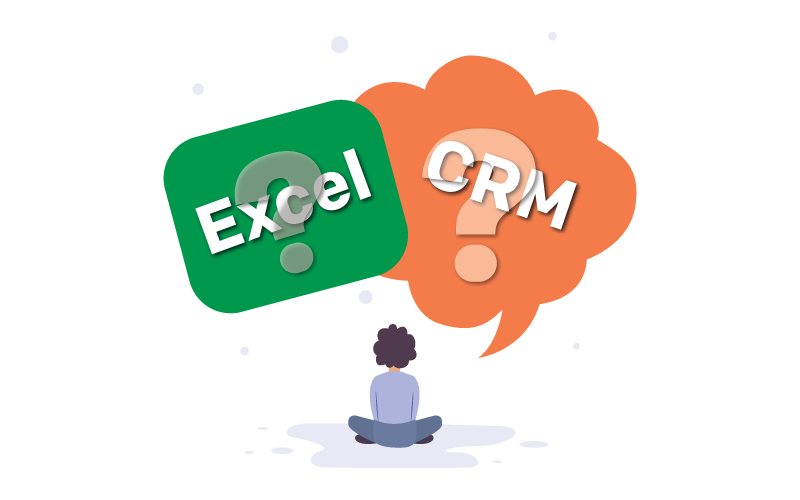Excel vs CRM: Choose the best for your Education Institute

For almost three decades, educational institutions have heavily relied on Excel sheets as their primary tool for managing data. Much like artists with a canvas, educators and administrators create, manipulate, and organize data within these familiar grids.
In the past, proficiency in Excel was nearly a prerequisite for any job description. Even today, many still pause scrolling to watch a quick tutorial for that Excel shortcut. There’s a deep-seated fondness for colourful columns and rows, often at the expense of efficiency and conversion rates.
However, with the emergence of new technologies like Education CRM (customer relationship management), the landscape of data management in educational institutes has evolved.
While Excel remains a cornerstone tool, CRM systems and marketing automation platforms have entered the market, offering enhanced functionalities and capabilities. These systems aim to complement or even replace Excel, addressing its limitations and catering to the specific needs of educational institutions in areas such as admissions, marketing, and lead management.
Yet, despite these advancements, decision-makers often find themselves at a crossroads when choosing between the tried-and-true Excel sheets and the evolving CRM (customer relationship management) systems. Many still opt for Excel, drawn by its zero cost and ease of use.
However, it’s essential to acknowledge that, while Excel is undoubtedly a powerful tool for data management, it falls short in crucial areas.
7 Areas where Excel is limiting your Admissions team Efficiency

1. Lack of Control and Security
Excel sheets lack robust control mechanisms, making it difficult to manage access permissions and ensure data security. Without proper controls, sensitive information could be compromised, leading to potential legal and reputational risks for your institution.
A scenario could arise where an unauthorized staff member gains access to sensitive admission data, such as student transcripts or financial information. This could lead to breaches of privacy regulations and damage your institution’s reputation.
2. Prone to Human Error
Manual data entry and manipulation in Excel are prone to human error, which can result in inaccuracies and inconsistencies in admissions records. These errors not only undermine the credibility of the data but also lead to inefficiencies in decision-making processes.
Manual data entry errors in Excel could result in duplicate student records or incorrect input of important application information, leading to confusion and delays in the admissions process. For instance, a typo in a student’s contact information could result in missed communications or misdirected correspondence.
3. Difficulty in Consolidation
As your institution grows and diversifies, managing multiple Excel sheets becomes increasingly complex and time-consuming. Consolidating data from various sources into a single, coherent view becomes a daunting task, hampering effective analysis and reporting.
Imagine a scenario where you are managing multiple Excel sheets for different departments or campuses. Consolidating data for reporting purposes becomes challenging. This could lead to discrepancies in enrollment numbers or financial reporting, impacting the institution’s ability to make informed decisions.
4. Unsuitable for Agile Admissions Practices
Excel lacks the agility needed to adapt to rapidly changing admissions practices and requirements. Institutions that are striving for innovation and flexibility in their admissions processes find themselves constrained by Excel’s rigid structure and limited functionalities.
Suppose your institution wants to introduce new admissions criteria or change application requirements quickly in response to market demands. Excel’s rigid structure and lack of automation make it difficult to implement these changes swiftly, resulting in delays and missed opportunities to attract qualified candidates.
5. Inability to Facilitate Quick Decisions
Timely decision-making is crucial in the competitive landscape of education. However, Excel’s manual processes and lack of real-time data visibility hinder the ability to make quick, informed decisions, potentially resulting in missed opportunities and inefficiencies.
During peak admissions periods, such as application deadlines or enrollment events, admissions teams need real-time visibility into application statuses and enrollment figures to make quick decisions. Excel’s manual processes and lack of real-time updates could result in delays in processing applications or missed enrollment targets.
6. Not Designed for Collaborative Work
Collaboration among admissions team members is essential for efficient operations. Excel’s limitations in facilitating real-time collaboration and version control often lead to disjointed workflows and communication breakdowns within the team.
In a collaborative admissions environment, multiple team members may need to access and update the same Excel sheet simultaneously. Without real-time collaboration features or version control, conflicting edits or data discrepancies may arise, leading to confusion and errors in applicant management.
7. Vulnerability to Fraud and Corruption
Excel’s decentralized nature and lack of audit trails make it susceptible to fraud and corruption. Without proper monitoring and controls, unauthorized access and data manipulation can go undetected, posing significant risks to the integrity of admissions processes.
For instance, a staff member with access to sensitive data could manipulate admission statistics or financial records to misrepresent your institution’s performance, leading to potential fraud or corruption allegations.
Why Education CRM is the best choice for your Institute?

While Excel has served as a familiar tool for data management in education institutes, its limitations have become increasingly evident as institutions strive for efficiency, security, and agility in their admissions processes.
Transitioning to a specialized CRM designed for educational institutions is not just a step forward; it’s a necessity in today’s dynamic educational landscape.
By leveraging a CRM built with the unique requirements of educational institutions in mind, you gain access to a comprehensive suite of tools and features.
Here’s How:
Streamlining Processes
Education CRM systems offer tailored workflows and automation features specifically designed for admissions processes. From lead management to enrollment, these systems streamline tasks such as application tracking, document management, and communication with prospective students.
By automating repetitive tasks and standardizing processes, admissions teams can focus on nurturing relationships with applicants and providing personalized support throughout the admissions journey.
Enhancing Collaboration
Unlike Excel sheets, CRM systems provide a centralized platform for collaboration among admissions team members. Real-time data updates, task assignments, and communication tools within the CRM foster collaboration and ensure everyone is aligned towards common goals.
Additionally, features like shared calendars and document repositories facilitate seamless teamwork, improving overall efficiency and effectiveness.
Making Data-Driven Decisions with Confidence
Robust CRM systems offer comprehensive analytics and reporting dashboards that empower admissions teams to make data-driven decisions with confidence. By consolidating data from various sources and providing customizable dashboards and reports, CRMs enable you to gain valuable insights into their admissions funnel, student demographics, and counsellor performance metrics.
This data-driven approach allows for informed decision-making, optimization of recruitment strategies, and identification of areas for improvement.
Ensuring Security and Compliance
Unlike Excel sheets, education CRM comes with built-in security features and compliance measures to safeguard sensitive admissions data. Role-based access controls, encryption, and audit trails ensure data integrity and protect against unauthorized access or manipulation.
Additionally, CRM systems often adhere to industry-specific regulations and standards, providing peace of mind to educational institutions in terms of data security and regulatory compliance.
Facilitating Personalized Engagement
Education CRM enables personalized engagement with prospective students throughout the admissions process. By capturing and analyzing student interactions, preferences, and interests, CRMs allow institutions to tailor communications and offerings to individual needs.
From targeted email campaigns, and drip marketing to personalized recruitment events, CRM systems help build meaningful relationships with applicants, ultimately increasing enrollment rates and student satisfaction.
Smart Features of an Advanced Education CRM

An advanced Education CRM like ExtraaEdge Education CRM empowers educational institutions with intelligent tools and insights. Thereby streamlining their entire admissions processes, enhancing student engagement, and ultimately driving higher enrollment rates.
Lead Prioritization through Lead Scores: Each prospective student is assigned a unique number based on their interactions with the counsellor. This allows admissions teams to prioritize their efforts on leads that exhibit higher levels of engagement and are more likely to convert into enrolled students. Read more about the same.
Targeted Marketing through Advanced Filters: The system enables you to segment your target audience using advanced filters based on various criteria such as demographics, course, and academic qualifications.
Monitoring Counselor Efficiency: By tracking interactions between counsellors and prospective students within the CRM system, you can assess counsellor efficiency and effectiveness in guiding students through the admissions process.
Application Completion Score: Education CRMs provide insights into the progress of each applicant through the admissions process, including the completion status of their application. This allows admissions teams to identify bottlenecks in the application process and take proactive measures.
Embedded Two-way WhatsApp: Integration with popular messaging platforms like WhatsApp enables seamless communication between admissions teams and prospective students. This feature allows for real-time engagement within the CRM.
Auto Lead Assignment: Through automation, you can assign incoming leads to the appropriate counsellors or admissions representatives based on predefined criteria such as location, program of interest, or lead score. This ensures timely follow-up and increases the chances of converting leads into enrolled students.
Wrapping Up
Excel is a great tool but has serious limitations when it comes to managing your admissions & marketing. And as your admission activities grow, using Excel as a CRM becomes increasingly difficult — if not impossible. A good Admission CRM focused on institutes offers a better way to manage the lead journey, admit data & complete the funnel from leads to admissions. This core investment in an education-focused CRM will help you increase, manage & predict your admission year on year.
PS: You can Book a 30-minute Demo with our admissions expert to experience the efficiency of “An Advanced Education CRM.”


